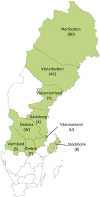Mammography screening reduces rates of advanced and fatal breast cancers: Results in 549,091 women
- PMID: 32390151
- PMCID: PMC7318598
- DOI: 10.1002/cncr.32859
Mammography screening reduces rates of advanced and fatal breast cancers: Results in 549,091 women
Abstract
Background: It is of paramount importance to evaluate the impact of participation in organized mammography service screening independently from changes in breast cancer treatment. This can be done by measuring the incidence of fatal breast cancer, which is based on the date of diagnosis and not on the date of death.
Methods: Among 549,091 women, covering approximately 30% of the Swedish screening-eligible population, the authors calculated the incidence rates of 2473 breast cancers that were fatal within 10 years after diagnosis and the incidence rates of 9737 advanced breast cancers. Data regarding each breast cancer diagnosis and the cause and date of death of each breast cancer case were gathered from national Swedish registries. Tumor characteristics were collected from regional cancer centers. Aggregated data concerning invitation and participation were provided by Sectra Medical Systems AB. Incidence rates were analyzed using Poisson regression.
Results: Women who participated in mammography screening had a statistically significant 41% reduction in their risk of dying of breast cancer within 10 years (relative risk, 0.59; 95% CI, 0.51-0.68 [P < .001]) and a 25% reduction in the rate of advanced breast cancers (relative risk, 0.75; 95% CI, 0.66-0.84 [P < .001]).
Conclusions: Substantial reductions in the incidence rate of breast cancers that were fatal within 10 years after diagnosis and in the advanced breast cancer rate were found in this contemporaneous comparison of women participating versus those not participating in screening. These benefits appeared to be independent of recent changes in treatment regimens.
Keywords: breast cancer; fatality; mammography; mortality; screening.
© 2020 The Authors. Cancer published by Wiley Periodicals, Inc. on behalf of American Cancer Society.
Conflict of interest statement
László Tabár received personal fees from General Electric Healthcare for the preparation of automated breast ultrasound teaching cases as well as honoraria and travel costs to attend speaking engagements; personal fees from Mammography Education Inc in his capacity as president of the company, which organizes continuing medical education courses regarding breast imaging; and personal fees from Three Palm Software for consultation related to breast imaging interpretation, all for work performed outside of the current study. The authors do not consider these conflicts of interest but disclose them for completeness. The other authors made no disclosures.
Figures





References
-
- Tabar L, Vitak B, Chen TH, et al. Swedish two‐county trial: impact of mammographic screening on breast cancer mortality during 3 decades. Radiology. 2011;260:658‐663. - PubMed
-
- IARC Working Group on the Evaluation of Cancer‐Preventive Strategies . Breast Cancer Screening. Vol 15 IARC Press; 2016.
-
- Swedish Organised Service Screening Evaluation Group . Reduction in breast cancer mortality from organized service screening with mammography: 1. Further confirmation with extended data. Cancer Epidemiol Biomarkers Prev. 2006;15:45‐51. - PubMed
-
- Njor S, Nystrom L, Moss S, et al; Euroscreen Working Group . Breast cancer mortality in mammographic screening in Europe: a review of incidence‐based mortality studies. J Med Screen. 2012;19(suppl 1):33‐41. - PubMed

